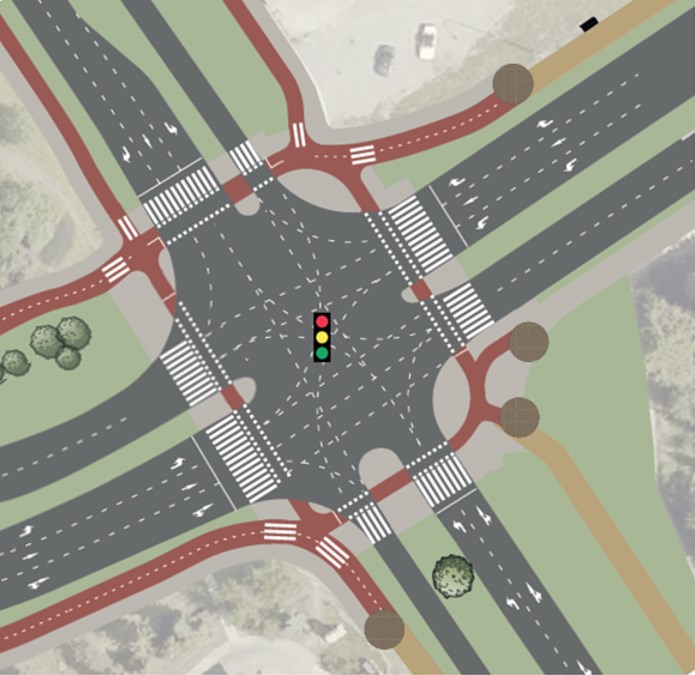CANMORE – One of Canmore’s busiest intersections will eventually be redesigned to help reduce traffic congestion, improve pedestrian safety and create a more esthetically pleasing entrance to town.
The intersection at Bow Valley Trail, Benchlands Trail and Railway Avenue will be redesigned as part of the Town’s integrated traffic plan that also includes redesigning all three roads as well as Palliser Road.
While construction is still years away and will require a lot more community engagement, redesigning the intersection where three of these roads meet will be critical to the success of the Town’s transportation plan.
“Bow Valley Trail is an important intersection in Canmore and will become more important over time because the intersection is where everything comes together for everyone who is travelling into Canmore from all directions,” said Lennart Nout, an urban mobility specialist with Mobycon, a Dutch-based company.
His company’s concept design plan includes creating a protected intersection that separates vehicles as much as possible from pedestrians and cyclists by using islands, medians and set backs.
The plan, which was presented to council on April 16, envisions eliminating one lane of traffic onto Railway Avenue as drivers enter town and eliminating one lane of traffic in each direction when turning onto Bow Valley Trail. Two lanes will remain for drivers heading up Benchlands Trail.
To ensure the intersection functions properly, the integrated traffic master plan also envisions redesigning Railway Avenue.
“Making sure this road works for everybody becomes more and more important if we want to increase capacity of people moving from the neighbourhoods around the town centre to the town centre,” said Nout.
His company’s design concept envisions eliminating one lane in each direction on Railway Avenue with dedicated turning lanes at intersections and a centre boulevard.
The plan also includes bike lanes on both sides of the road, wider sidewalks and eliminating on-street parking. There will also be a significant amount of landscaping to make the street greener.
“In Dutch we call this a ‘driving slower goes quick’ system,” said Nout, adding cars will still be able to cross the boulevard to access businesses on the other side of the road.
“We use this in many urban or suburban streets where we take a street and optimize the flow so there’s fewer obstructions. By having a single lane at a lower speed we get more through [in terms] of the number of cars.”
At the intersection of Railway Avenue and Main Street, the plan also calls for a protected intersection and the option to be able to change the length of the advance green signal onto Main Street to restrict the number of cars entering the town centre.
The first phase of construction for Railway Avenue isn’t expected to begin until 2021 with the central part of the road and rehabilitation of Bow Valley Trail planned for 2023-24.
In the meantime, construction to redesign Palliser Trail is expected to begin in 2020 with one lane eliminated in each direction, so the Town can add a mixed-used pathway and turning lanes on both sides of the road. Benchlands Trail and the overpass will also be reconfigured to accommodate a new mixed-used, separated pathway over the highway heading into town by eliminating one lane of traffic.
In 2020, the Town will continue to implement its integrated traffic plan by improving pedestrian access from the intersection of Bow Valley Trail and Railway Avenue to Spring Creek Drive. Pathways on the west side of Bow Valley Trail will also be improved along with two pedestrian crossings on Benchland Trail at Cougar Creek Drive east and west. Improvement to the two pedestrian crossings will need to be approved by council before construction can begin.
“All of this will be built under a single contract with one overarching pedestrian, cycle and vehicle accommodation plan,” said Andy Esarte, manager of engineering for the Town.
The following year, the Town intends to begin rehabilitating Second Avenue in Teepee Town. The plan includes upgrading the area’s utilities and improving pedestrian connectivity, particularly pedestrian access to the hospital. Construction is expected to begin in 2021-22.
While Railway Avenue will eventually be reduced to one lane in each direction with a central median and turn bays at key intersections, Bow Valley Trail will actually be expanded from two lanes to three lanes with a central median and turn bays to properly convert what was once a former highway into an urban street.
“The Integrated Transportation Plan envisions two and three lane cross sections for all of our arterial roadways – one lane each direction plus turn bays at key intersections and a central median at pedestrian crossing locations to improve traffic flow and safety,” wrote Esarte in a follow up email.
“For Railway Avenue, the south section will be three to four lanes to accommodate turn movements and train queuing, the central section will be converted from four lanes to three lanes, and the north section will see the addition of a median and turn bays. In a future year, Bow Valley Trail will receive a central median at pedestrian crossing locations together with turn bays at key intersections.”
Construction for Bow Valley Trail and the central part of Railway Avenue isn’t expected to start until 2023-24.




